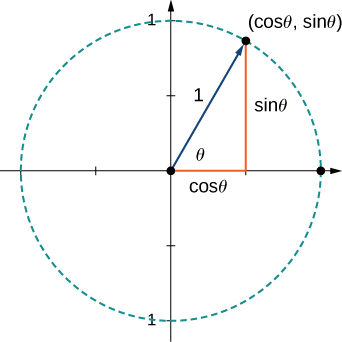1. Vectors in the Plane
When describing the movement of an airplane in flight, it is important to communicate two pieces of information: the direction in which the plane is traveling and the plane’s speed. When measuring a force, such as the thrust of the plane’s engines, it is important to describe not only the strength of that force, but also the direction in which it is applied. Some quantities, such as velocity or force, are defined in terms of both size (also called magnitude) and direction. A quantity that has magnitude and direction is called a vector. In this text, we denote vectors by boldface letters, such as v.
Definition
A vector is a quantity that has both magnitude and direction.
Vector Representation
A vector in a plane is represented by a directed line segment (an arrow). The endpoints of the segment are called the initial point and the terminal point of the vector. An arrow from the initial point to the terminal point indicates the direction of the vector. The length of the line segment represents its magnitude. We use the notation ![]() v
v ![]() to denote the magnitude of the vector v. A vector with an initial point and terminal point that are the same is called the zero vector, denoted 0. The zero vector is the only vector without a direction, and by convention can be considered to have any direction convenient to the problem at hand.
to denote the magnitude of the vector v. A vector with an initial point and terminal point that are the same is called the zero vector, denoted 0. The zero vector is the only vector without a direction, and by convention can be considered to have any direction convenient to the problem at hand.
Vectors with the same magnitude and direction are called equivalent vectors. We treat equivalent vectors as equal, even if they have different initial points. Thus, if v and
Definition
Vectors are said to be equivalent vectors if they have the same magnitude and direction.
The arrows in Figure 3.1.1(b) are equivalent. Each arrow has the same length and direction. A closely related concept is the idea of parallel vectors. Two vectors are said to be parallel if they have the same or opposite directions. We explore this idea in more detail later in the chapter. A vector is defined by its magnitude and direction, regardless of where its initial point is located.
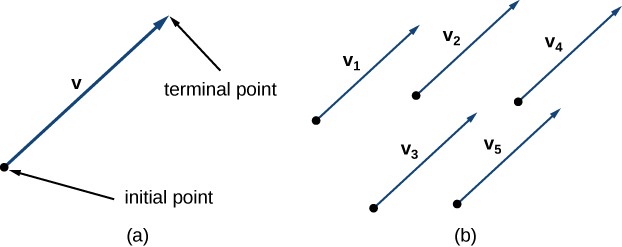
The use of boldface, lowercase letters to name vectors is a common representation in print, but there are alternative notations. When writing the name of a vector by hand, for example, it is easier to sketch an arrow over the variable than to simulate boldface type: ![]() . When a vector has initial point Pand terminal point Q, the notation
. When a vector has initial point Pand terminal point Q, the notation ![]() is useful because it indicates the direction and location of the vector.
is useful because it indicates the direction and location of the vector.
Example: Sketching Vectors
Sketch a vector in the plane from initial point P(1,1) to terminal point Q(8,5).
Solution:
Because the vector goes from point P to point Q, we name it ![]() .
.
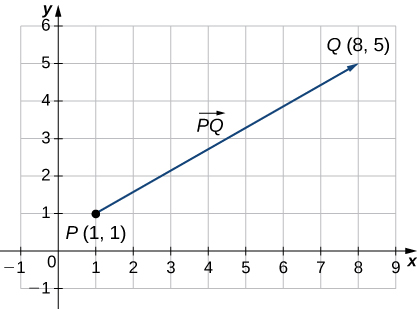
Combining Vectors
Vectors have many real-life applications, including situations involving force or velocity. For example, consider the forces acting on a boat crossing a river. The boat’s motor generates a force in one direction, and the current of the river generates a force in another direction. Both forces are vectors. We must take both the magnitude and direction of each force into account if we want to know where the boat will go.
A second example that involves vectors is a quarterback throwing a football. The quarterback does not throw the ball parallel to the ground; instead, he aims up into the air. The velocity of his throw can be represented by a vector. If we know how hard he throws the ball (magnitude—in this case, speed), and the angle (direction), we can tell how far the ball will travel down the field.
A real number is often called a scalar in mathematics and physics. Unlike vectors, scalars are generally considered to have a magnitude only, but no direction. Multiplying a vector by a scalar changes the vector’s magnitude. This is called scalar multiplication. Note that changing the magnitude of a vector does not indicate a change in its direction. For example, wind blowing from north to south might increase or decrease in speed while maintaining its direction from north to south.
Definition
The product kv of a vector v and a scalar k is a vector with a magnitude that is ktimes the magnitude of v, and with a direction that is the same as the direction of v if k>0, and opposite the direction of v if k<0. This is called scalar multiplication. If k=0 or v=0, then kv=0.
As you might expect, if k=−1, we denote the product kv as kv=−1v=−v. Note that −v has the same magnitude as v, but has the opposite direction (Figure 3.1.2).
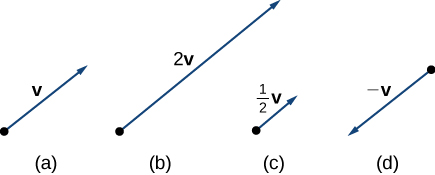
Another operation we can perform on vectors is to add them together in vector addition, but because each vector may have its own direction, the process is different from adding two numbers. The most common graphical method for adding two vectors is to place the initial point of the second vector at the terminal point of the first, as in Figure 3.1.3(a). To see why this makes sense, suppose, for example, that both vectors represent displacement. If an object moves first from the initial point to the terminal point of vector v, then from the initial point to the terminal point of vector w, the overall displacement is the same as if the object had made just one movement from the initial point to the terminal point of the vector v+w. For obvious reasons, this approach is called the triangle method. Notice that if we had switched the order, so that w was our first vector and v was our second vector, we would have ended up in the same place. (Again, see Figure 3.1.3(a).) Thus,
A second method for adding vectors is called the parallelogram method. With this method, we place the two vectors so they have the same initial point, and then we draw a parallelogram with the vectors as two adjacent sides, as in Figure 3.1.3(b). The length of the diagonal of the parallelogram is the sum. Comparing Figure 3.1.3(b) and Figure 3.1.3(a), we can see that we get the same answer using either method. The vector v+w is called the vector sum.
Definition
The sum of two vectors v and w can be constructed graphically by placing the initial point of w at the terminal point of v. Then, the vector sum, v+w, is the vector with an initial point that coincides with the initial point of v and has a terminal point that coincides with the terminal point of w. This operation is known as vector addition.

It is also appropriate here to discuss vector subtraction. We define v−w as v+−w=v+(−1)w. The vector v−w is called the vector difference. Graphically, the vector v−w is depicted by drawing a vector from the terminal point of w to the terminal point of v (Figure 3.1.4).
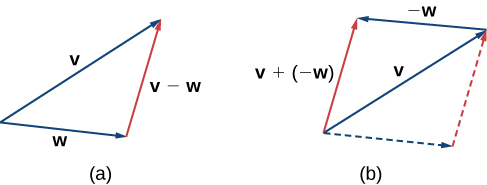
In Figure 3.1.4(a), the initial point of v+w is the initial point of v. The terminal point of v+w is the terminal point of w. These three vectors form the sides of a triangle. It follows that the length of any one side is less than the sum of the lengths of the remaining sides. So we have
![]() .
.
This is known more generally as the triangle inequality. There is one case, however, when the resultant vector u+v has the same magnitude as the sum of the magnitudes of u and v. This happens only when u and v have the same direction.
Example: Combining Vectors
Given the vectors v and w shown below, sketch the vectors (1) 3w, (2) v+w , and (3) 2v−w.

Solution
(1) The vector 3w has the same direction as w; it is three times as long as w.
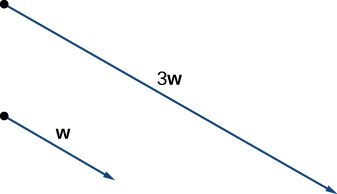
(2) Use either addition method to find v+w. To find v+w, align the vectors at their initial points or place the initial point of one vector at the terminal point of the other. (a) The vector v+w is the diagonal of the parallelogram with sides v and w. (b) The vector v+wis the third side of a triangle formed with wplaced at the terminal point of v.
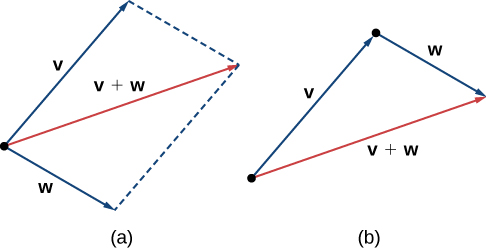
(3) To find 2v−w, we can first rewrite the expression as 2v+−w. Then we can draw the vector −w, then add it to the vector 2v.
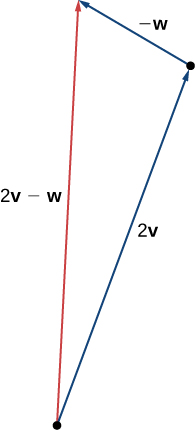
Vector Components
Working with vectors in a plane is easier when we are working in a coordinate system. When the initial points and terminal points of vectors are given in Cartesian coordinates, computations become straightforward.
Example: Comparing Vectors
Are v and w equivalent vectors?
(1) v has initial point (3,2) and terminal point (7,2), w has initial point (1,−4) and terminal point (1,0).
Solution
(1) The vectors are each 4 units long, but they are oriented in different directions. So v and w are not equivalent.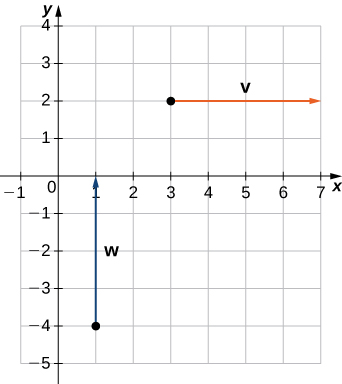
(2) Based on the figure below, and using a bit of geometry, it is clear these vectors have the same length and the same direction, so v and w are equivalent.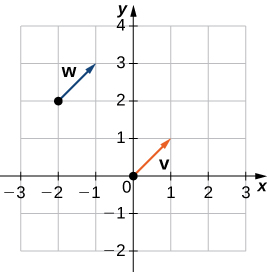
We have seen how to plot a vector when we are given an initial point and a terminal point. However, because a vector can be placed anywhere in a plane, it may be easier to perform calculations with a vector when its initial point coincides with the origin. We call a vector with its initial point at the origin a standard-position vector. Because the initial point of any vector in standard position is known to be (0,0), we can describe the vector by looking at the coordinates of its terminal point. Thus, if vector v has its initial point at the origin and its terminal point at (x,y), we write the vector in component form as
![]() .
.
When a vector is written in component form like this, the scalars x and y are called the components of v.
Definition
The vector with initial point (0,0) and terminal point (x,y) can be written in component form as
Recall that vectors are named with lowercase letters in bold type or by drawing an arrow over their name. We have also learned that we can name a vector by its component form, with the coordinates of its terminal point in angle brackets. However, when writing the component form of a vector, it is important to distinguish between ![]() and (x,y). The first ordered pair uses angle brackets to describe a vector, whereas the second uses parentheses to describe a point in a plane. The initial point of
and (x,y). The first ordered pair uses angle brackets to describe a vector, whereas the second uses parentheses to describe a point in a plane. The initial point of ![]() is (0,0); the terminal point of
is (0,0); the terminal point of ![]() is (x,y).
is (x,y).
When we have a vector not already in standard position, we can determine its component form in one of two ways. We can use a geometric approach, in which we sketch the vector in the coordinate plane, and then sketch an equivalent standard-position vector. Alternatively, we can find it algebraically, using the coordinates of the initial point and the terminal point. To find it algebraically, we subtract the x-coordinate of the initial point from the x-coordinate of the terminal point to get the x component, and we subtract the y-coordinate of the initial point from the y-coordinate of the terminal point to get the y component.
Rule: Component Form of a Vector
Let v be a vector with initial point (xi, yi) and terminal point (xt, yt). Then we can express v in component form as ![]() .
.
Example: Expressing Vectors in Component Form
Express vector v with initial point (−3,4) and terminal point (1,2) in component form.
Solution
(a) Geometric
- Sketch the vector in the coordinate plane.
- The terminal point is 4 units to the right and 2 units down from the initial point.
- Find the point that is 4 units to the right and 2 units down from the origin.
- In standard position, this vector has initial point (0,0) and terminal point (4,−2):
 .
.
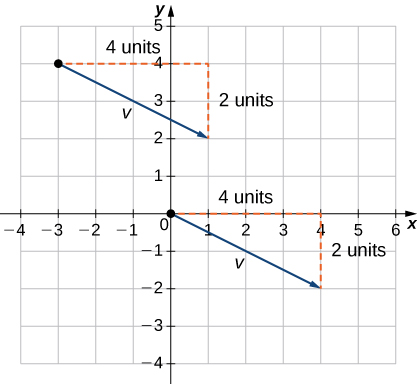
(b) Algebraic
In the first solution, we used a sketch of the vector to see that the terminal point lies 4 units to the right. We can accomplish this algebraically by finding the difference of the x-coordinates:
Similarly, the difference of the y-coordinates shows the vertical length of the vector.
So, in component form,

To find the magnitude of a vector, we calculate the distance between its initial point and its terminal point. The magnitude of vector ![]() is denoted
is denoted ![]() , and can be computed using the formula
, and can be computed using the formula
Note that because this vector is written in component form, it is equivalent to a vector in standard position, with its initial point at the origin and terminal point (x,y). Thus, it suffices to calculate the magnitude of the vector in standard position. Using the distance formula to calculate the distance between initial point (0,0) and terminal point (x,y), we have

Based on this formula, it is clear that for any vector v, ![]() ≥ 0, and
≥ 0, and ![]() = 0 if and only if v=0.
= 0 if and only if v=0.
The magnitude of a vector can also be derived using the Pythagorean theorem, as in the following figure.
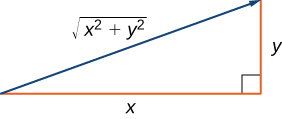
We have defined scalar multiplication and vector addition geometrically. Expressing vectors in component form allows us to perform these same operations algebraically.
Definition
Let ![]() and
and ![]() be vectors, and let k be a scalar.
be vectors, and let k be a scalar.
Scalar multiplication: k![]()
Vector addition: ![]()
Example: Performing Operations in Component Form
Let v be the vector with initial point (2,5) and terminal point (8,13), and let w=![]() .
.
- Express v in component form and find v. Then, using algebra, find
- v+w,
- 3v, and
- v−2w.
Solution
(1) To place the initial point of v at the origin, we must translate the vector 2 units to the left and 5 units down. Using the algebraic method, we can express v as v=![]() :
:
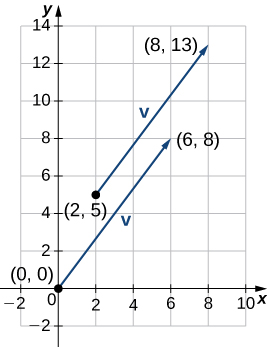
(2) To find v+w, add the x-components and the y-components separately: v+w=![]() .
.
(3) To find 3v, multiply v by the scalar k=3: 3v=3*![]() .
.
(4) To find v−2w, find –2w and add it to v: v−2w=![]() .
.
Now that we have established the basic rules of vector arithmetic, we can state the properties of vector operations. We will prove two of these properties. The others can be proved in a similar manner.
Theorem
Properties of Vector Operations
Let u, v, and w be vectors in a plane. Let r and s be scalars.

Proof of Commutative Property
Let u=![]() and v=
and v=![]() .
.
Apply the commutative property for real numbers:
□
Proof of Distributive Property
Apply the distributive property for real numbers:

□
We have found the components of a vector given its initial and terminal points. In some cases, we may only have the magnitude and direction of a vector, not the points. For these vectors, we can identify the horizontal and vertical components using trigonometry (Figure 3.1.6).
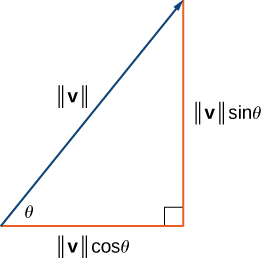
Consider the angle θ formed by the vector v and the positive x-axis. We can see from the triangle that the components of vector v are vcos θ,vsin θ. Therefore, given an angle and the magnitude of a vector, we can use the cosine and sine of the angle to find the components of the vector.
Unit Vectors
A unit vector is a vector with magnitude 1. For any nonzero vector v, we can use scalar multiplication to find a unit vector u that has the same direction as v. To do this, we multiply the vector by the reciprocal of its magnitude:
![]()
For ![]() , it follows that
, it follows that ![]() . We say that u is the unit vector in the direction of v (Figure 3.1.7). The process of using scalar multiplication to find a unit vector with a given direction is called normalization.
. We say that u is the unit vector in the direction of v (Figure 3.1.7). The process of using scalar multiplication to find a unit vector with a given direction is called normalization.

We have seen how convenient it can be to write a vector in component form. Sometimes, though, it is more convenient to write a vector as a sum of a horizontal vector and a vertical vector. To make this easier, let’s look at standard unit vectors. The standard unit vectors are the vectors i = ![]() and j =
and j =![]() (Figure 3.1.8).
(Figure 3.1.8).
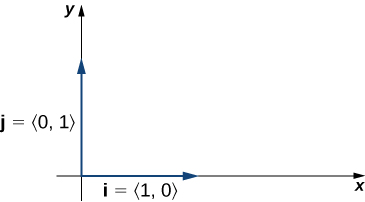
By applying the properties of vectors, it is possible to express any vector in terms of i and j in what we call a linear combination:
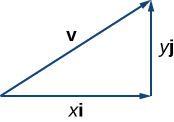
Example: Using Standard Unit Vectors
- Express the vector w=
 in terms of standard unit vectors.
in terms of standard unit vectors. - Vector u is a unit vector that forms an angle of 60° with the positive x-axis. Use standard unit vectors to describe u.
Solution
(1) Resolve vector w into a vector with a zero y-component and a vector with a zero x-component:
w=![]() .
.

